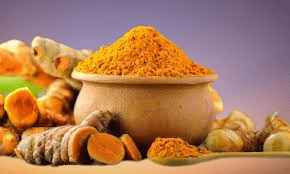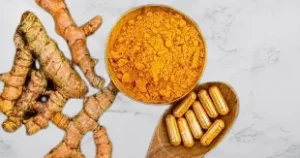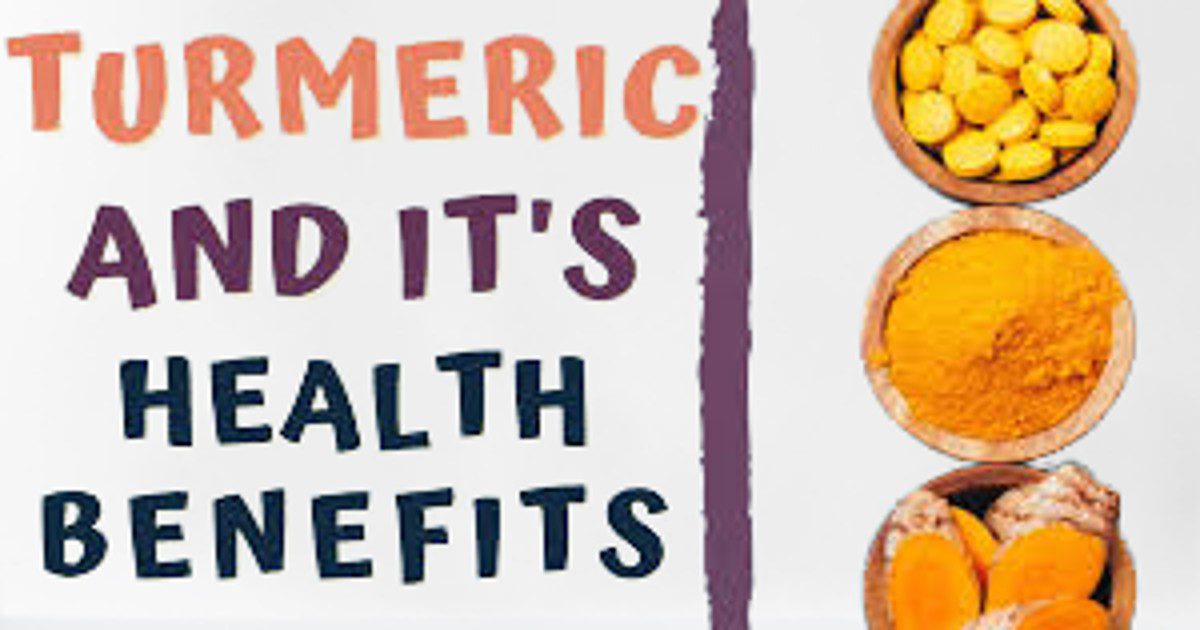Turmeric ( Local name of India, Haldi ) is a flowering plant, the rhizomes of which are used in cooking. The plant is perennial native to the Indian subcontinent and Southeast Asia that requires temperatures between 20 and 30 °C (68 and 86 °F) and high annual rainfall to thrive. Plants are gathered each year for their rhizomes, some for propagation in the following season and some for consumption.
Health Benefits of Turmeric

The rhizomes are used fresh or boiled in water and dried, after which they are ground into a deep orange-yellow powder commonly used as a coloring and flavoring agent in many Asian cuisines, especially for curries, as well as for dyeing, characteristics imparted by the principal turmeric constituent, curcumin. The Yellow colour is due to the presence of curcumin in it.
Curcumin, a bright yellow chemical produced by the plant, is approved as a food additive by the World Health Organization, European Parliament, and United States Food and Drug Administration.
It has been used in Asia for centuries and is a major part of Ayurveda, Siddha medicine, traditional Chinese medicine, Unani.
Details
Today, it is promoted as a dietary supplement for a variety of conditions, including arthritis, digestive disorders, respiratory infections, allergies, liver disease, depression, and many others.
Scientific Name – Curcuma longa
Plant Type – perennial herbaceous plant
Plant Height – Up to1 m (3 ft 3 in) tall
The powder is about 60–70% carbohydrates, 6–13% water, 6–8% protein, 5–10% fat, 3–7% dietary minerals, 3–7% essential oils, 2–7% dietary fiber, and 1–6% curcuminoids.
Home Remedies / Natural Remedies
Anti-Inflammatory
Inflammation can result in various health conditions including heart diseases, metabolic syndrome, and even cancer, as well as cognitive decline. It has a powerful anti-inflammatory property which can help in reducing inflammation and prevent the potential health issues. The best way of using it is to add it in your food. For instance, top up your salad with a pinch or two.
Anti-Oxidant
Curcumin is also a powerful anti-oxidant and thus protects our body from free radicals, reducing the risk of heart disease and cancer. It has been found to enhance the antioxidant capacity and fights free-radical damages. This offers benefits for brain functions and immune system. It can increase the natural antioxidant capacity of your body and boost up the defense system to fight and eliminate any potential dangers. This also provides protection to your skin from environmental pollutants. You can include a teaspoon of turmeric in your smoothie or green juice to give your body an antioxidant boost.
Delays Diabetes
Curcumin delays the onset of type 2 diabetes by inhibiting the formation of inflammatory cytokines and thus having a favourable effect on blood glucose levels.
Immunity Booster
It also boosts immunity levels. Its anti-bacterial, anti-viral and anti-fungal properties protect us from a variety of infections. Many doctors highly recommend taking a teaspoon full of it in a glass of warm milk every day to keep the common cold and flu at bay. Curcumin has antimicrobial, antioxidant, and anti-inflammatory properties which makes it a powerhouse of health promotion. Although curcumin doesn’t properly absorb well in the bloodstream but consuming it with black pepper can help in enhancing its absorption rate.
Reduces the Risk of Heart Diseases
The anti-oxidant property of curcumin may prevent heart diseases and diabetic cardiovascular complications. Curcumin also reduces serum cholesterol levels and protects against the pathological changes occurring with atherosclerosis. Both turmeric and curcumin have been found to safeguard the heart in many ways including fighting free radical damage, decreasing inflammation, and enhancing endothelial function. Therefore, it is recommended to add cooking turmeric to high fiber dishes like barley, quinoa, or rice.
Reduces Risk of Cancer
Curcumin interferes with the growth and development of cancer cells and prevents their spread at the minutest molecular level. Thus, it effectively reduces the risk of new cancerous growth. Research has also shown that curcumin and turmeric can play a role in preventing and treating cancerous cells. It is known as a natural cancer fighting agent with promising findings in both human and animal studies.
Helps Patients with Depression
Curcumin boosts BDNF( brain-derived neurotrophic factor) levels in the brain, thus helping patients with depression. Curcumin also boosts the brain neurotransmitters serotonin and dopamine. Curcumin in turmeric has also been found to have potential uses in treatments for depression through reversing the harmful brain changes which happen in depressive state. Research has also shown its ability to potentially increase levels of mood-regulating neurotransmitters like dopamine and serotonin.
Anti-Ageing Effects
The anti-oxidant properties of curcumin prevents damage to the cells and thus slows down ageing. It effectively prevents the formation of fine lines and wrinkles. Curcumin also stimulates new cell growth.
Improves Bone Health
Supplements of Curcumin when given to patients suffering from rheumatoid arthritis, shows significant improvements in pain and joint functioning. Curcumin also safeguards bone tissue and prevents bone loss. The anti-inflammatory properties help in easing joint pain. Research has demonstrated promising outcomes of the ability of curcumin and turmeric to manage inflammation and pain liked with arthritis. It also helps reduce soreness for athletes.
Improves Digestion
Curcumin reduces bloating and brings the digestive system on track. It stimulates the gallbladder to produce bile. It also helps in preventing and treating pancreatitis. Turmeric plays an important role in aiding food digestion. This golden spice contributes towards healthy digestion due to its anti-inflammatory and antioxidant properties. It has been utilized in Ayurvedic medicine for centuries as a digestive healing agent. In recent years, western medicine has also started exploring the ways it can assist in reduce inflammation in the gut to enhance the efficiency of the digestive system.
Treatment of Glaucoma and Cataract
The anti-oxidant property helps in treating glaucoma and cataract. Regular consumption of Turmeric halts the progression of glaucoma and also prevents vision loss too.
Good Skin
It has anti-inflammatory, antimicrobial and antioxidant properties that can help to:
- Heal wounds
- Prevent acne and breakouts
- Fight eczema and psoriasis
- Reduce scars
- Lighten dark circles
- Give a natural glow
High cholesterol
Research suggests that taking turmeric extract by mouth twice daily for 3 months reduces total cholesterol, low-density lipoprotein (LDL or “bad”) cholesterol, and triglycerides in overweight people with high cholesterol.
How to take?
- Curry sauce. Probably the most common way to use is to make a curry sauce. If you’re a fan of Indian cuisine, you can find many recipe variations with the earthy, bitter taste of turmeric as a star ingredient in this bold sauce.
- Soups. Spice up plain ol’ chicken soup by adding some powdered or grated turmeric to your mirepoix (the mixture of sautéed chopped veggies like onions, celery, and carrots that forms the base of your soup).
- Stews. Similar to how you’d start a soup base, you can make a stew base by sizzling some aromatics like onions and garlic with some turmeric and ginger for a burst of flavor.
- Smoothies. A dash of turmeric blends well with coconut water, honey, and a variety of fruit, like pineapple, blueberries, and mango.
- Oatmeal. Add a pinch of powdered turmeric, along with some chopped dates, for a savory twist on your morning bowl of oatmeal.
- With milk (a.k.a. Golden Milk). For this soothing drink, made with warm milk and honey, just add a pinch of dried turmeric to give it a golden glow.
- Tea. You can buy packaged turmeric tea at many grocery stores, but you can also make it at home. Just steep dried or fresh turmeric in water for a delicious, golden beverage.
- Marinades. Often mixed with yogurt to balance the flavor and tenderize the meat, powdered turmeric lends a brilliant hue to marinades.
- Spice rubs. You can blend some complementary spices (like turmeric and ginger) as a bold, spice rub for poultry or lamb.
- Exotic combos like fresh turmeric and coconut or fresh-from-the-farm blends like fresh turmeric, lemons, and peaches make tasty chutneys a delicious, spreadable treat.
- Scrambled eggs. Instead of seasoning your eggs with salt and pepper, switch out the salt for turmeric.
- Muffins. Muffin recipes abound with heavenly combinations such as turmeric, carrots, shredded coconut, and chia seeds.
- Grains. Sprinkle in a bit of it when cooking grains like quinoa or rice, adding in some cashews and raisins for an Indian-inspired twist.
- Roasted veggies. Before you toss those bite-sized chunks of broccoli, carrots, or potatoes into the oven, drizzle with a little olive oil and sprinkle with turmeric.
- Lentils. Add a little turmeric to the cooking water when making lentils and other legumes.

SIDE EFFECTS
It is LIKELY SAFE when taken by mouth or applied to the skin appropriately for up to 8 months.
Turmeric is POSSIBLY SAFE when it is used as an enema or a mouthwash in the short-term.
It usually does not cause significant side effects; however, some people can experience stomach upset, nausea, dizziness, or diarrhea.
In one report, a person who took very high amounts, over 1500 mg twice daily, experienced a dangerous abnormal heart rhythm. However, it is unclear if turmeric was the actual cause of this side effect. Until more is known, avoid taking excessively large doses.
Thanks for visiting read4knowledge. Hope you liked the article
